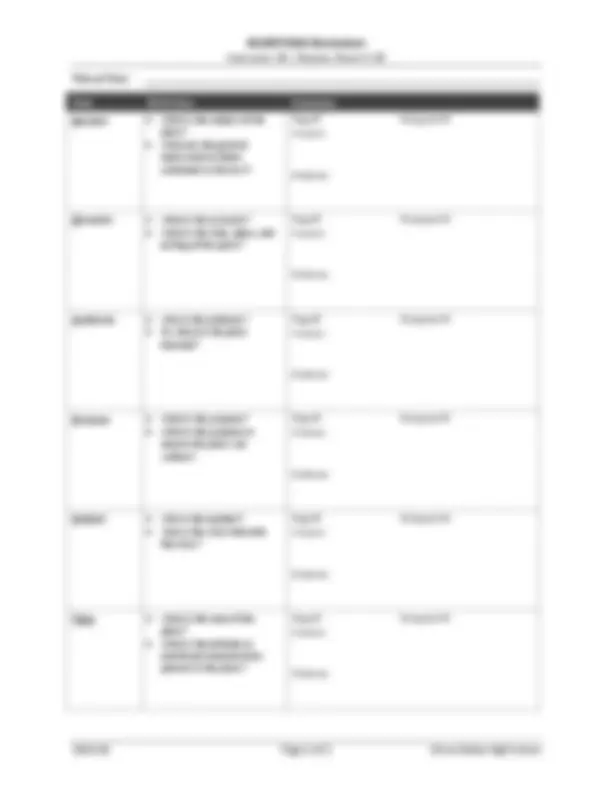



Study with the several resources on Docsity

Earn points by helping other students or get them with a premium plan


Prepare for your exams
Study with the several resources on Docsity

Earn points to download
Earn points by helping other students or get them with a premium plan
Community
Ask the community for help and clear up your study doubts
Discover the best universities in your country according to Docsity users
Free resources
Download our free guides on studying techniques, anxiety management strategies, and thesis advice from Docsity tutors
The SOAPSTone strategy for written analysis is a simple method of rhetorical criticism designed to help with the process of analyzing texts, writing about ...
Typology: Summaries
1 / 2

This page cannot be seen from the preview
Don't miss anything!


SOAPSTONE Worksheet Instructor: Mr. Shearer, Room C-
2019-20 Page 1 of 2 Citrus Valley High School
The SOAPSTone strategy for written analysis is a simple method of rhetorical criticism designed to help with the process of analyzing texts, writing about written texts, and even planning for the writing of an original text. SOAPSTone is an acronym, standing for Speaker, Occasion, Audience, Purpose, Subject, and Tone and is used to analyze rhetorically texts we read in class.
By utilizing the six parts of the SOAPSTone strategy, you can take nearly any written text (for example, a novel, journal article, speech, creative nonfiction piece, or any other written document) and develop a good sense for what the author was intending to do with the document and how audiences may (or may not) react to the text.
SPEAKER : DETERMINE THE SPEAKER. Identify who is telling the story or giving the information. Is it an omniscient narrator, a character in the story, or the actual author? Why do you think the author chose that person to be the speaker? What details about this person are important to know?
OCCASION : RECOGNIZE THE OCCASION. The occasion refers to the time and place of the story or written document. When and where do the events take place? From what geographical and chronological context is the speaker thinking and acting? How does the time and place affect and inform the text? What details are given about the occasion in the text itself?
AUDIENCE : DESCRIBE THE AUDIENCE. Consider the primary, secondary, and even tertiary audiences of this text. Who was the text written for? Why was it written for them? What characteristics do you know about the audience and how do you know that the text was written with them in mind?
PURPOSE : ESTABLISH THE PURPOSE. Why would the author write this particular text for the audience you noted above? Determine the meaning and message underlying the prose and ask yourself: what value does this give to my audience? What does the author think or hope the audience of the text will think about the text or do as a result of it? How does the author effectively (or ineffectively) make his or her purpose clear and realize the purpose’s goals?
SUBJECT : INVESTIGATE THE SUBJECT. Knowing the audience and purpose of the document, in conjunction with the occasion and speaker allows you to better understand the subject or topic of the text. What is the author really getting at? What belies the story or prose, possibly providing a deeper meaning? What does the author reveal (or not reveal) when addressing the subject?
TONE : DISSECT THE TONE. Evaluate the word choice, organization, and rhetorical patterns in the prose. How do the textual elements make the audience feel? How does the author feel about the subject? Is the message heavy-handed, or is it subtle? What can you say about the syntactical construction and structure of the text in regards to tone?
On the following worksheet, you are to identify the rhetorical situation for texts we read in class. List the title of the text then complete the form with as much detail as you can provide.
SOAPSTONE Worksheet Instructor: Mr. Shearer, Room C-
2019-20 Page 2 of 2 Citrus Valley High School
Title of Text :
Item Definition Examples
Speaker ^ What is the subject of the piece? What are the general topics/and/or/ideas contained in the text?
Page #: Paragraph #: Analysis:
Evidence:
Occasion What is the occasion? What is the time, place, and setting of the piece?
Page #: Paragraph #: Analysis:
Evidence:
Audience Who is the audience? To whom is the piece directed?
Page #: Paragraph #: Analysis:
Evidence:
Purpose ^ What is the purpose? What is the purpose or reason this piece was written?
Page #: Paragraph #: Analysis:
Evidence:
Subject Who is the speaker? Who is the voice that tells the story?
Page #: Paragraph #: Analysis:
Evidence:
Tone What is the tone of the piece? What is the attitude or emotional characteristics present in the piece?
Page #: Paragraph #: Analysis:
Evidence: